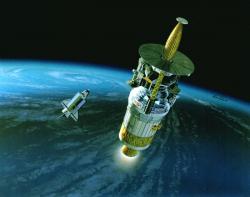Written by Ian O'Neill
Strange things are happening to our robotic space explorers. Also known as the "Pioneer effect" (the unexpected and sudden alterations to Pioneer 10 and Pioneer 11 trajectories measured as they continue their journey into the outer solar system), similar anomalies are being seen in flybys by modern space probes. Earth flybys by Galileo, Rosetta, NEAR and Cassini have all experienced a sudden boost in speed. After cancelling out all possible explanations, including leakage of fuel and velocity measurement error, a new study suggests the answer may lie in a bizarre characteristic of universal physics…
Planetary flybys are an essential aid to interplanetary missions to gain energy as they accelerate on their merry way to their destination. Gravity assists are accurately calculated by mission scientists so the time of arrival can be calculated down to the minute. Considering most missions take years to complete, this degree of accuracy is amazing, but essential.
So, when Galileo completed gravity assist past Earth on December 8, 1990, to speed it toward Jupiter, you can imagine NASA's surprise to find that Galileo had accelerated suddenly, and for no apparent reason. This small boost was tiny, but through the use of the Deep Space Network, extremely accurate measurements of the speeding craft could be made. Galileo had accelerated 3.9 mm/s.
This isn't an isolated case. During Earth flybys by the space probes NEAR, Cassini-Huygens and Rosetta, all experienced a unexplained boosts of 13 mm/s, 0.11 mm/s and 2 mm/s respectively. Once technical faults, observational errors, radiation pressure, magnetic instabilities and electrical charge build-up could be ruled out, focus is beginning to turn to more exotic explanations.
A recent study by Magic McCulloch suggests that "Unruh radiation" may be the culprit. The Unruh effect, put simply, suggests that accelerating bodies experience a type of electromagnetic radiation. At very low acceleration, the wavelength emitted will be so large that a whole wavelength will be longer than the dimensions of the Universe (otherwise known as the Hubble Distance). Low acceleration would therefore generate waves that have no effect on the body. However, should the accelerating body (i.e. Galileo getting accelerated by Earth's gravity during the 1990 flyby) slowly exceed an acceleration threshold, the Unruh radiation will decrease in wavelength (smaller than the Hubble Distance), causing a tiny, but measurable "boost" to its increasing velocity.
Although complex, this theory is very interesting and proves that although we can calculate the arrival time of space probes down to the nearest minute, the Universe will continue to throw up some perplexing issues for a long time yet.
Sources: arXiv Blog, arXiv abstract and paper download
Filed under: Physics, Space Flight
Lucimary Vargas
Além Paraíba-MG-Brasil
observatorio.monoceros@gmail.com

Nenhum comentário:
Postar um comentário